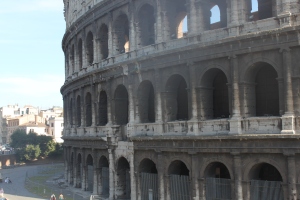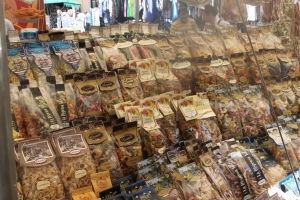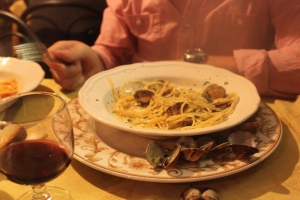Mamma still makes spaghetti, the markets of Rome, Italy
There are no chairs left, so I order a macchiato, and stand at the counter. I join a small group of older market stand owners, mostly men, who never having grown up drinking water, are fighting off the afternoon heat with a glass of cold white wine. It’s the end of the day, so produce is being sold off at lower prices, covered or packed up. There are two slot machines at the side of the counter, and whilst back home in North America, the image of a woman alone, standing at a bar and playing pokies could be seen as tacky, not here. As if confirming this, my husband and son walk in, and exclaim in unison ‘what are you doing?’
This it Italy, the land of La Dolce Vita (or The Sweet Life), where men aren’t afraid to openly tell a woman she is beautiful, where women old and young still look like ladies, where mamma (not the Pope) is revered, and spaghetti and pizza are not treated like the carbohydrate anti-Christ, but are prepared with a simple finesse and eaten with gusto by all.
Mercato Trionfale is down the road from the Vatican City, a large under-cover space where you can find everything you need for the Italian kitchen. I spent a full morning in there, and as we were on the move on an almost daily basis, picnic supplies such as buffalo mozzarella, home-cured sausages, hams, freshly baked bread and fruits of the season such as figs, the juiciest grapes, peaches, quickly made their way in my shopping bags. What was particularly refreshing about this place, was that as prices were low, the market was full of the average Signor and Signora, as well as students, and nearby office workers stopping in to do their daily grocery shopping. Refreshing as I find that many Western markets are becoming so over-priced, and attract only a certain type of moneyed market goer, making the actual idea of a market- a common place of trade and commerce unaffordable to most people. Refreshing also, as I found the markets of Rome sold some of the best produce I had eaten anywhere, but sold without the airs and graces that seem to cropping up in many farmers’ markets stalls.
Across town, I go to Campo Dei Fiori located in the Piazza di Campo de Fiori, Rome. The square is bordered by a number of small grocery stalls and a couple of restaurants and cafés. A great looking place, yet obviously orientated towards tourists; pasta, spices and olive oils were being sold alongside souvenirs.
Sitting down to a restaurant meal in Rome is an enlightening experience. Firstly, nobody raises an eyebrow about children being brought along; restaurant tables all over Rome are full of kids and their parents, and often their uncles and aunties, their cousins, grandparents, and on several occasions, we counted four generations dining together. I made a point to see whether the Italian food as we know it best in the Western world, i.e. Pizza and Spaghetti are as common as they are back home.
Listening to dietary warnings, about empty calories and weight gain, I cut down on the pasta and rice intake years ago, so was pleasantly surprised to see young and old still tucking into plates of spaghetti and slices of pizza at every sit down. What was different was the simplicity of these meals, spaghetti with a simple pesto or tomato sauce, cooked al dente and in the very best olive oil. Then there was the lightest gnocchi which I had once with octopus, another time with a bolognese sauce which my seven year old swapped with me for his burger (without the bun!).
In actual fact, pasta is eaten at every meal. A typical Italian dinner will start with an appetizer such as a plate of antipasto to share, or a vegetarian option (my favourites were zucchini flowers with ricotta or fried potato croquettes). This is then followed by the ‘first course’ which is typically pasta, and if you’re still game, the ‘second course’ is either a meat or fish dish with a side. As for pizza (we must have had at least one a day) – the lightest crusts, the freshest, simplest toppings, as opposed to the culturally unrecognisable, super-sized ‘pies’ which have you running for the alka seltzer (and the couch!).
Keeping these things in mind, it doesn’t surprise me that the Slow Food Movement had its origins in Italy. The Italian plate respects the Slow Food Movement’s three-pronged approach of being Good, Clean and Fair. Whilst this approach extends beyond gastronomy to agriculture and food production; the very fact that the everyday Roman benefits from accessible prices for food, that Italians are protecting their national gastronomic heritage, and produce is both seasonally abundant and fresh gives testimony that whilst the Italians prefer to keep to their gastronomic origins (as opposed to opting for a more multicultural diet) they are doing something very right.
Back in Canada, and still having unpacked, we go out for a quick meal at a ‘family restaurant’. The place is advertising a new kid’s meal, ‘Spaghetti Coockooricko’ a strange hodgepodge of egg noodles, peas, chicken fillet, swimming in a béchamel type sauce. I think back to my last meal in Rome, a simple spaghetti pomodoro (Spaghetti with tomato sauce), and consider that even though I may not be in Rome anymore, I’m going to continue to do as the Romans.
Spaghetti Vongole (spaghetti with fresh clams)
One of my favourite meals was a simple spaghetti with clams, or Spaghetti Vongole. Whilst he is obviously not Italian, Jamie Oliver’s passion for all things Italian are well known, so I have included his recipe here. If you don’t like clams, skip them and just add more tomatoes.
Buon Appetito!
Click here a full list of markets in Rome







